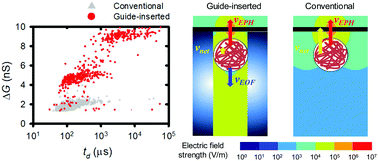Our official English website, www.x-mol.net, welcomes your
feedback! (Note: you will need to create a separate account there.)
Enhancing the sensitivity of DNA detection by structurally modified solid-state nanopore
Nanoscale ( IF 5.8 ) Pub Date : 2017-10-30 00:00:00 , DOI: 10.1039/c7nr05840c Kidan Lee 1, 2, 3, 4 , Hyomin Lee 2, 3, 4, 5 , Seung-Hyun Lee 1, 2, 3, 4 , Hyun-Mi Kim 1, 2, 3, 4 , Ki-Bum Kim 1, 2, 3, 4, 6 , Sung Jae Kim 2, 3, 4, 5, 7
Nanoscale ( IF 5.8 ) Pub Date : 2017-10-30 00:00:00 , DOI: 10.1039/c7nr05840c Kidan Lee 1, 2, 3, 4 , Hyomin Lee 2, 3, 4, 5 , Seung-Hyun Lee 1, 2, 3, 4 , Hyun-Mi Kim 1, 2, 3, 4 , Ki-Bum Kim 1, 2, 3, 4, 6 , Sung Jae Kim 2, 3, 4, 5, 7
Affiliation

|
Solid-state nanopore is an ionic current-based biosensing platform, which would be a top candidate for next-generation DNA sequencing and a high-throughput drug-screening tool at single-molecular-scale resolution. There have been several approaches to enhance the sensitivity and reliability of biomolecule detection using the nanopores particularly in two aspects: signal-to-noise ratio (SNR) and translocation dwell time. In this study, an additional nano-well of 100–150 nm diameter and the aspect ratio of ∼5 called ‘guide structure’ was inserted in conventional silicon-substrate nanopore device to increase both SNR and dwell time. First, the magnitude of signals (conductance drop (ΔG)) increased 2.5 times under applied voltage of 300 mV through the guide-inserted nanopore compared to the conventional SiN/Si nanopore in the same condition. Finite element simulation was conducted to figure out the origin of ΔG modification, which showed that the guide structure produced high ΔG due to the compartmental limitation of ion transports through the guide to the sensing nanopore. Second, the translocation velocity decreased in the guide-inserted structure to a maximum of 20% of the velocity in the conventional device at 300 mV. Electroosmotic drag formed inside the guide structure, when directly applied to the remaining segment of translocating DNA molecules in cis chamber, affected the DNA translocation velocity. This study is the first experimental report on the effect of the geometrical confinement to a remnant DNA on both SNR and dwell time of nanopore translocations.
中文翻译:

通过结构修饰的固态纳米孔提高DNA检测的灵敏度
固态纳米孔是基于离子电流的生物传感平台,它将成为下一代DNA测序的最佳候选者,并且是单分子级分辨率的高通量药物筛选工具。已经存在几种使用纳米孔增强生物分子检测的灵敏度和可靠性的方法,特别是在两个方面:信噪比(SNR)和易位停留时间。在这项研究中,在传统的硅基板纳米孔器件中插入了直径为100-150 nm的另一个纳米孔,其长宽比约为5,称为“引导结构”,以增加SNR和停留时间。首先,信号的大小(电导降(ΔG))在相同条件下,通过引导插入的纳米孔在300 mV的施加电压下比传统的SiN / Si纳米孔增加了2.5倍。进行了有限元模拟,以找出ΔG修饰的起源,这表明由于离子通过引导进入传感纳米孔的空间限制,引导结构产生了较高的ΔG。其次,在引导插入结构中的易位速度降低到最大,为传统设备在300 mV时的速度的20%。当直接应用于顺式易位DNA分子的其余部分时,在引导结构内部形成电渗阻力室,影响了DNA的易位速度。这项研究是关于残余DNA的几何限制对SNR和纳米孔易位的停留时间的影响的第一份实验报告。
更新日期:2017-11-23
中文翻译:

通过结构修饰的固态纳米孔提高DNA检测的灵敏度
固态纳米孔是基于离子电流的生物传感平台,它将成为下一代DNA测序的最佳候选者,并且是单分子级分辨率的高通量药物筛选工具。已经存在几种使用纳米孔增强生物分子检测的灵敏度和可靠性的方法,特别是在两个方面:信噪比(SNR)和易位停留时间。在这项研究中,在传统的硅基板纳米孔器件中插入了直径为100-150 nm的另一个纳米孔,其长宽比约为5,称为“引导结构”,以增加SNR和停留时间。首先,信号的大小(电导降(ΔG))在相同条件下,通过引导插入的纳米孔在300 mV的施加电压下比传统的SiN / Si纳米孔增加了2.5倍。进行了有限元模拟,以找出ΔG修饰的起源,这表明由于离子通过引导进入传感纳米孔的空间限制,引导结构产生了较高的ΔG。其次,在引导插入结构中的易位速度降低到最大,为传统设备在300 mV时的速度的20%。当直接应用于顺式易位DNA分子的其余部分时,在引导结构内部形成电渗阻力室,影响了DNA的易位速度。这项研究是关于残余DNA的几何限制对SNR和纳米孔易位的停留时间的影响的第一份实验报告。











































 京公网安备 11010802027423号
京公网安备 11010802027423号